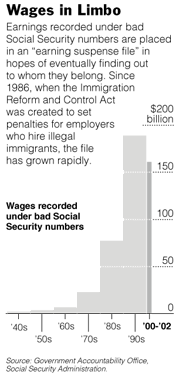In the current decade, the [earnings suspense] file is growing, on average, by more than $50 billion a year, generating $6 billion to $7 billion in Social Security tax revenue and about $1.5 billion in Medicare taxes.Look at how the file ballooned:
In 2002 alone, the last year with figures released by the Social Security Administration, nine million W-2's with incorrect Social Security numbers landed in the suspense file, accounting for $56 billion in earnings, or about 1.5 percent of total reported wages.
. . . . . . . . . . . . . . . . . . . .
"Our assumption is that about three-quarters of other-than-legal immigrants pay payroll taxes," said Stephen C. Goss, Social Security's chief actuary, using the agency's term for illegal immigration. (Porter, 5 Apr. 2005)
Undocumented workers and their employers' contributions amount to as much as 10% of last year's Social Security surplus (Porter, 5 Apr. 2005). Most importantly, taxes that they pay are factored into "all the Social Security Administration's projections" (Porter, 5 Apr. 2005), making debates on Social Security and immigration inseparable.
The more immigrants come to America, the more solvent Social Security will be.
Most immigration helps Social Security's finances, because new immigrants tend to be of working age and contribute more than they take from the system. A simulation by Social Security's actuaries found that if net immigration ran at 1.3 million a year instead of the 900,000 in their central assumption, the system's 75-year funding gap would narrow to 1.67 percent of total payroll, from 1.92 percent -- savings that come out to half a trillion dollars, valued in today's money.Without immigrant workers, legal or illegal, younger Americans would have to pay more taxes to support a growing proportion of the US population who are 65 and older:
Illegal immigrants help even more because they will never collect benefits. According to Mr. Goss, without the flow of payroll taxes from wages in the suspense file, the system's long-term funding hole over 75 years would be 10 percent deeper. (Porter, 5 Apr. 2005)
"We the People: Aging in the United States" (Yvonne J. Gist and Lisa I. Hetzel, US Census Bureau, December 2004) shows that about 97.4% of the US population aged 65 and older are citizens (of whom 6.9% are foreign-born naturalized citizens). In contrast, half of all new workers (and 80% of all new male workers) who entered the labor force (not counting the military) in the 1990s are immigrants, and new and old immigrants account for 14% of the labor force, according to a 2002 study by the Center for Labor Market Studies at Northeastern University (Andrew Sum, Neeta Fogg, Paul Harrington, Ishwar Khatiwada, Mykhaylo Trub’skyy, and Sheila Palma, "Immigrant Workers and the Great American Job Machine: The Contributions of New Foreign Immigration to National and Regional Labor Force Growth in the 1990s," December 2002):
male female Population of the United States, by Age and Sex, 1950-2050 (millions)
Source: Ed Stephan, "Aging of the United States, 1950-2050" (data obtained from U.S. Census Bureau, International Data Base)
Immigrants are indispensable. As America grows older and deeper in debt, it can't afford xenophobia.
(D'Vera Cohn, "Immigrants Account for Half of New Workers: Report Calls Them Increasingly Needed For Economic Growth," Washington Post 2 Dec. 2002, p. A1)







No comments:
Post a Comment